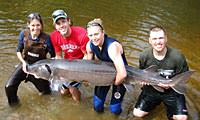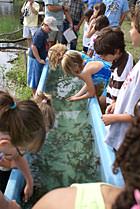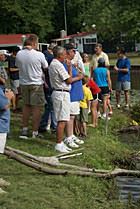2007 Black Lake Sturgeon Research Summary
By: James Crossman, Michigan State University
We had a tremendous year this year despite it being a large transitional year for our research project. The spring began in the typical fashion with the fish were ready to spawn before we were completely ready for them to. Nonetheless we had another fantastic year monitoring adult spawning activity in the Upper Black River.
We caught our first fish on April 23rd and our last one June 1st. June is the latest we have ever captured an adult on the spawning grounds. We captured a total of 208 fish this year, the second largest in the past seven years. You would guess that after seven years of tagging a large proportion of the spawning adult population that we would be getting close to having mostly fish returning to spawn that we had handled in previous years. This was not the case as we had 88 brand new fish on the spawning grounds this year ranging from small males to large females. We captured the longest fish ever in our seven years of tagging this year. She measured in at 6 feet 6 inches total length. To date we have tagged a total of 614 unique individuals spawning in the Upper Black. Of the 208 fish captured and tagged this year, 145 were males and 63 were females. One very encouraging result was that 45 of the 63 females captured were new and untagged.

Despite the large number of fish spawning in the early spring, larval drift sampling turned out to be one of our lowest years in terms of total capture. A very large rain event that increased water levels in the Upper Black River and persisted for about 10 days likely had detrimental effects on both egg and larval survival. A total of 1,426 larval fish were captured and brought back to the streamside rearing facility to grow for the summer months. This was the last summer for the streamside hatchery at its current location on the mouth of the Upper Black. It was a wonderful three years at our spot on Crist Isle Drive and we thank all the people who gave us so much support and encouragement.

We stocked a total of 1000 fish into Black Lake in mid-August. The fish were released right on the hatchery grounds and we had a great turnout of both kids and adults who had an interest in helping to let the fish go. Both visual and snorkeling reports from local residents indicate that the juvenile sturgeon were doing well and slowly moving out of the river system. Once the fish were gone we had the pleasant task of dismantling and storing the building, along with all the tanks and piping, that once made up the streamside hatchery. It was a bittersweet end to a very productive research project the past three years.
In conclusion I would like to personally thank all the individuals that made our research at the streamside river possible over the past three years. Even more important are the wonderful friendships that were developed over my time on Black Lake. The area will always hold a special place in my heart no matter where life takes me. Take care and see you on the lake.
- Home Page
- Black Lake
Sturgeon Shivaree - Black Lake Watershed
- Black Lake Sturgeon Management Plan
- Committees
- Contact Us
- Directors
- Events
- Habitat Conservation
- Membership
- Newsletters
- Our History
- Photo Gallery
- Research
- Resources
- Resources for Educators
- SFT Scholarships
- Spearing Guidelines
- State Regulations
- Sturgeon Guarding
- Sturgeon Hatchery
- Sturgeon in the Classroom

